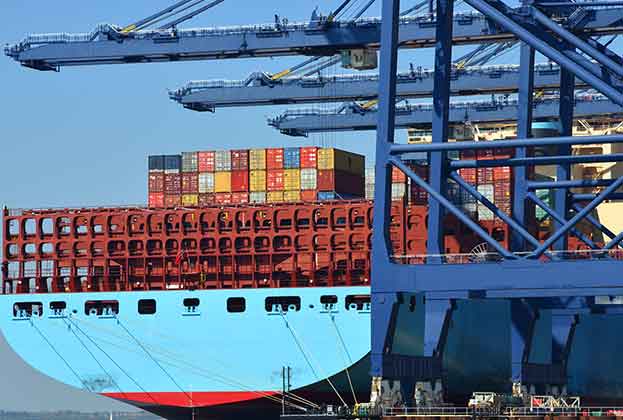Port-centric logistics allows you to store your shipment at the port thus reducing the number of handling stages throughout your storage and distribution process, in theory saving both time and money
Humber International Enterprise Park
.jpg)
Overview of opportunity
Humber International Enterprise Park (HIEP) is strategically located adjacent to the Port of Hull on the North Bank of the River Humber, the UK’s ‘Energy Estuary’. The site has an area of 183 hectares (453 acres) of development land with potential quayside access to the adjacent Port of Hull via a dedicated railroad link connecting the site into the respective UK networks.
The site is one of the largest allocated industrial employment development sites in the UK. An outline planning application for circa 400,000 square metres of logistics and manufacturing space is due to be approved in Q4 2020.
ABP has the in house financial resource, expertise and the experience to design and build bespoke manufacturing and logistics facilities from single buildings to multi-let units.
The site is fully serviced, and grant funding is available.
Supply chain drivers and potential cost savings for locating at Hull
The Department for Transport published the annual statistics on the UK’s major ports which confirmed the Humber ports combined are the biggest port complex in the UK by a factor of two. The Humber accounts for 23% of all goods travelling through English ports. It adds £7.6 billion GDA to the UK economy per year and supports 35,000 jobs across the North.
The Port of Hull is just 20 miles (32km) from the North Sea. The port is well connected by dual carriageway road links to the M62 and then M18 and M1, to service the whole of the British Isles. In addition, the port is connected to the main rail network and inland waterways system. We see rail access as becoming increasingly important to operators as they look to reduce costs and their carbon footprint.
The Port of Hull is the heart of the offshore wind sector on the Humber, the UK’s energy estuary. In 2017, Green Port Hull was opened at the port, a £310 million joint venture between ABP and Siemens to create a renewable energy hub with world-class offshore wind turbine blade manufacturing, assembly and servicing facilities as its centrepiece. The port is strategically located to serve the Round 3 and Round 4 wind farm zones.
In addition, the port is the UK’s leading softwood timber port and has regular ferry and container services connecting mainland Europe, and beyond. Multimillion pound investment in the Hull Container Terminal has cemented the city’s position as a leading gateway for trade, offering reliable and resilient supply chain solutions.
Multimillion pound investment in the Hull Container Terminal has cemented the city’s position as a leading gateway for trade, offering reliable and resilient supply chain solutions
Savills Research
From a labour perspective, the North East has the highest number of job seekers in the UK at an unemployment rate of 5.4%, and the greater Hull area has a working population between 16 and 64 of 625,000 workers – 85% of which are trained with NVQ2 to NVQ4+.
New research commissioned by Associated British Ports (ABP) has revealed the major benefits of choosing Hull and Immingham for moving cargo between key logistics hubs in the UK and EU, demonstrating why Humber ports offer a better deal for shippers, drivers and the environment.
A comparative analysis of short sea import and export routes to and from the UK conducted by the University of Hull Logistics Institute has demonstrated the significant time, distance and environmental benefits which can be achieved by choosing the ports of Hull and Immingham instead of the Port of Dover, as well as other ports located on the east coast.
The study identifies major logistics hubs located within the ‘Central East-West’ corridor of the UK, including destinations such as Leeds, Doncaster and Manchester. By using the Humber instead of Dover, the average reduction in distance travelled to the selected locations was 178 miles, with an average cut in journey times of 5 hours 10 minutes, and an average saving of 458kg CO2e per load.
The study estimates that moving 10% of cargo from the Port of Dover to the Humber could save in the region of 100,000 tonnes of CO2e every year when travelling to locations within Central East-West Corridor.
University of Hull Logistics Institute’s study findings has been reinforced by a report delivered by leading consultancy MDS Transmodal. In their report, MDS compared the distances and time between the UK’s five principal warehouse clusters, located in the Midlands and northern England, and other ports on the east coast, including Dover in the South East. The report shows that Hull and Immingham are the only ports which are within four hours of each cluster.
In terms of journey time and distance, Hull is the closest east coast port to Liverpool / Manchester and Leeds / Yorkshire clusters, closely followed by Immingham. Immingham is the closest port to the South Yorkshire / East Midlands and West Midlands clusters, followed by Hull. Tilbury, owned by ABP’s competitor Forth Ports, is the closest to the Northamptonshire cluster.
In the last two years, ABP has already noticed a shift in trade volumes with cargo originally destined for southern ports, such as Dover, increasingly moving north as trade partners look at alternatives to mitigate any difficulties the more traditional routes may experience in the future.
DP World London Gateway
.jpg)
Overview of opportunity
DP World London Gateway is the UK’s most productive port covering a site of 1140 acres in the South East of England just 28 miles from central London. Currently, the port has three deep-water berths with a fourth under construction and can handle 2.1m TEU a year with a capacity to double; it is connected to 115 other global ports through 23 weekly services.
The port is well prepared for whatever is the UK’s future trading relationships with the rest of the world will be, given that 90% of current throughput is from outside the EU. This means that systems and processes are already in place.
The port site can accommodate warehouse development up to 9.25m sq ft and is regarded as the largest facility of its kind in Europe. The logistics park also benefits from a Local Development Order meaning that planning permission for future development can be obtained within 28 days.
Supply chain drivers and potential cost savings for locating at London Gateway
For products where speed to market is key, using London Gateway for inbound UK distribution can offer a competitive advantage when compared to distributing from traditional locations in the Midlands.
Within just 30 miles there are over 3.5 million unique delivery addresses, and by choosing to locate close to those delivery addresses many efficiencies can be gained.
London Gateway is a modern port with state of the art infrastructure, this means that fewer days are lost to weather disruption compared to other ports, and users of the port can expect to load and unload their vehicles with a 35-minute turn around – 50% faster than other ports. The port also has a dedicated rail freight terminal where 45 services to other locations within the UK run each week.
London Gateway is a modern port with state of the art infrastructure, this means that less days are lost to weather disruption compared to other ports
Savills Research
Occupiers of London Gateway are already seeing supply chain efficiencies. For example, 14% of the current throughput of the port is for refrigerated produce meaning that 65% of the population is closer than in previous supply chain models. This reduces the need to run vehicles empty and can help reduce Carbon impact by as much as 1.38kg per mile.
The occupiers at London Gateway also benefit from lower demurrage charges due to the private estate roads on the site and the fact that London Gateway can offer an integrated service, which it permits out of gauge cargo.
Case study material from occupiers on-site demonstrates the geographical location and lower operating costs on-site can amount to savings of £1.75m per year based on moving 100,000 pallets of refrigerated produce.
From the perspective of labour, London Gateway has over half a million potential workers within a 30-minute drive time. The port also has a significant labour pool of contracted workers meaning the port is well equipped to ‘flex’ to demand and seasonal throughput.
Read the articles within Spotlight: Port-centric Logistics below.


